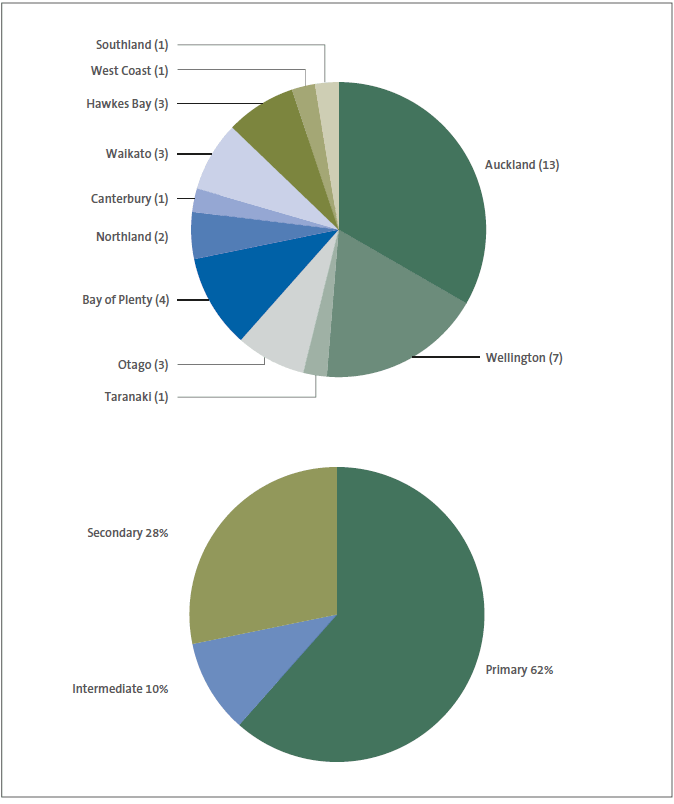Part 1: Introduction
1.1
In this Part, we discuss:
- the purpose of our audit;
- what we audited;
- what we did not audit;
- how we carried out our audit; and
- the structure of this report.
The purpose of our audit
1.2
The student's learning environment is critical to their success. Given the nature and scale of the school property portfolio, the portfolio needs to be well managed to support the education outcomes that students, parents, schools, and the Ministry of Education (the Ministry) wants.
1.3
The school property portfolio is one of the largest publicly owned portfolios of property assets and arguably the most complex. From Te Hapua School in the north to Halfmoon Bay School in the south, each school is at the heart of its community. As at 30 June 2016, the school property portfolio included more than 2100 operational state schools,2 with total land and buildings valued at about $14 billion.
1.4
Managing each school property involves a multi-layered relationship between school boards of trustees (school boards), school leaders, and the Ministry. Although school boards own and manage some property, the Ministry owns most school land and buildings. School boards are required to keep the buildings they use in good condition. The Ministry provides maintenance funding to school boards annually to maintain school property. Capital investment in school property can be through either school-led projects or national interventions managed by the Ministry.
1.5
This report sets out the results of a performance audit that considered how well the Ministry is managing the school property portfolio and supporting schools with their responsibilities for property.
1.6
We have carried out several performance audits on school property. Our last report, Ministry of Education: Management of the school property portfolio, was published in 2006 and included 24 recommendations.
What we audited
1.7
In this report, we look at the Ministry as an asset manager and how it works with schools to maintain and improve the school property portfolio. We wanted to see:
- the effectiveness of The New Zealand School Property Strategy 2011-2021 (the Property Strategy);
- the effectiveness of the Ministry as an asset manager;
- how well the Ministry supports schools in property matters; and
- whether the Ministry provides schools with the right information and tools to plan for and manage their property.
1.8
We focused on how the Ministry works with the more than 2100 school boards of state (non-integrated) schools around the country. The Ministry, through its role as asset manager, wants to ensure that school property is in the right location and right condition, so school boards can provide a suitable learning environment for their students and meet the needs of future generations.
1.9
Where still relevant, we followed up the recommendations from our 2006 report. There have been significant changes at the Ministry since then. Appendix 1 sets out the Ministry's progress against these recommendations.
What we did not audit
1.10
We did not seek to assess the physical state of the school property in the portfolio, nor seek to quantify future investment needs.
1.11
We have excluded the following from our review because their circumstances are different from the rest of the portfolio:
- reviewing and rebuilding of schools affected by the 2010 and 2011 Canterbury earthquakes, which are covered by the Christchurch School Rebuild Programme; and
- funding and managing of state-integrated school property throughout the country.
How we carried out our audit
1.12
We interviewed staff in the Ministry, including staff in:
- national leadership positions;
- specialist areas, such as procurement, risk, health and safety, and engineering;
- regional leadership positions;
- programme leadership positions; and
- regional operating positions, including Ministry Advisors.
1.13
The Ministry's management of assets, in particular the school property portfolio, has been the subject of recent external reviews. We considered the scope and findings of these reviews and refer to them where appropriate.
1.14
We gained an understanding of schools' perspectives on property-related matters by interviewing principals and board members from 39 schools throughout the country (see Figure 1). We selected a cross-section of schools with different property needs, collected property information about each school, and used it to prepare a questionnaire for each school. These questionnaires were the basis for the interviews, which took place between April 2016 and June 2016.
1.15
Although 39 schools from a portfolio of more than 2100 schools does not represent a statistically significant sample, it has provided an insight into how schools deal with property management and the daily issues that schools face.
1.16
We also spoke with representatives from the New Zealand Principals' Federation, New Zealand School Trustees Association, and members of the Ministry's property "focus groups", including principals and school-appointed property planners and project managers. We also visited a school that has had significant property issues in recent years.
The structure of this report
1.17
In Part 2, we describe the school property portfolio and how it is managed.
1.18
In Part 3, we discuss the Ministry's Property Strategy and how well the Ministry plans, monitors, and reports on its performance against the strategy.
1.19
In Part 4, we discuss the Ministry's effectiveness at managing the school property portfolio.
1.20
In Part 5, we discuss how well the Ministry supports schools in property matters and whether schools have the right information and tools to plan for and manage their property.
Figure 1
Sample of schools by location and type

2: This excludes state-integrated schools, which are former private schools now part of the state education system that provide education within the framework of a religious or philosophical belief. Proprietors provide and maintain the school land and buildings.

